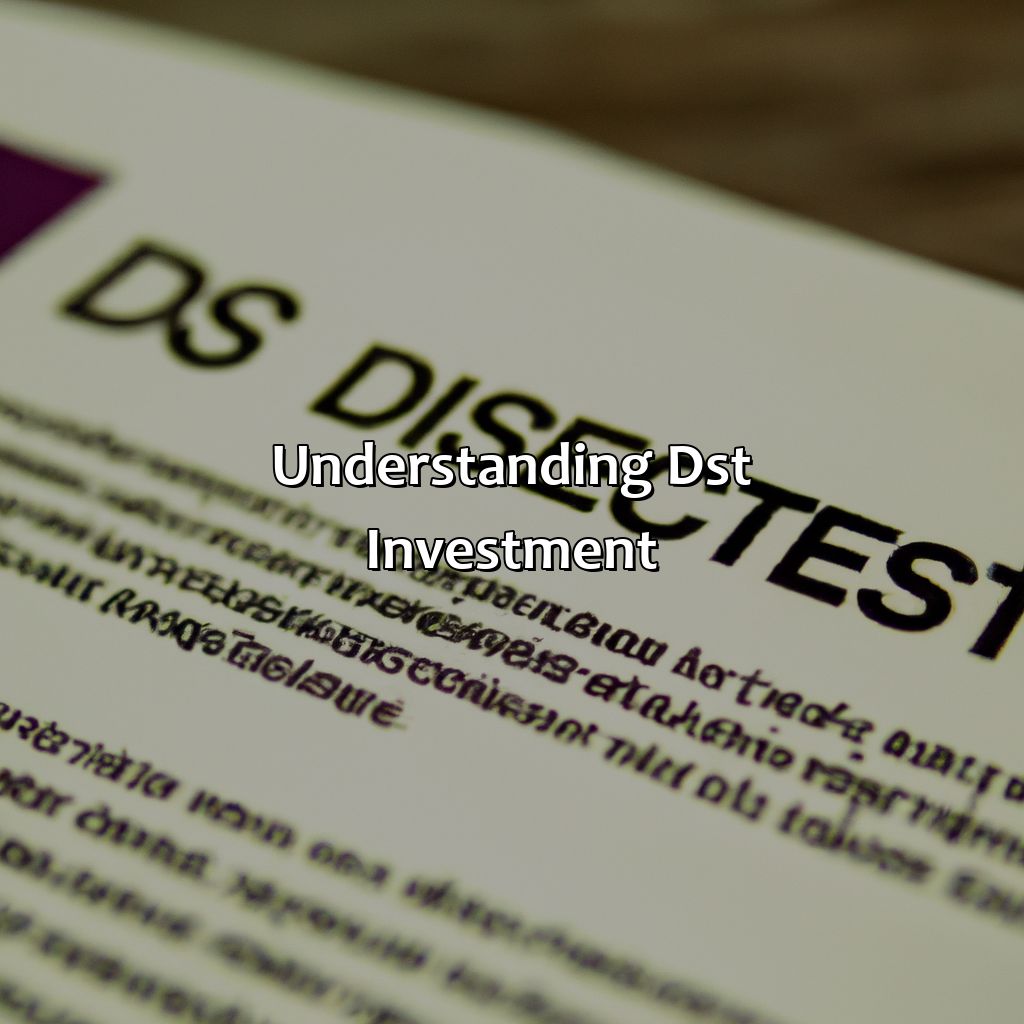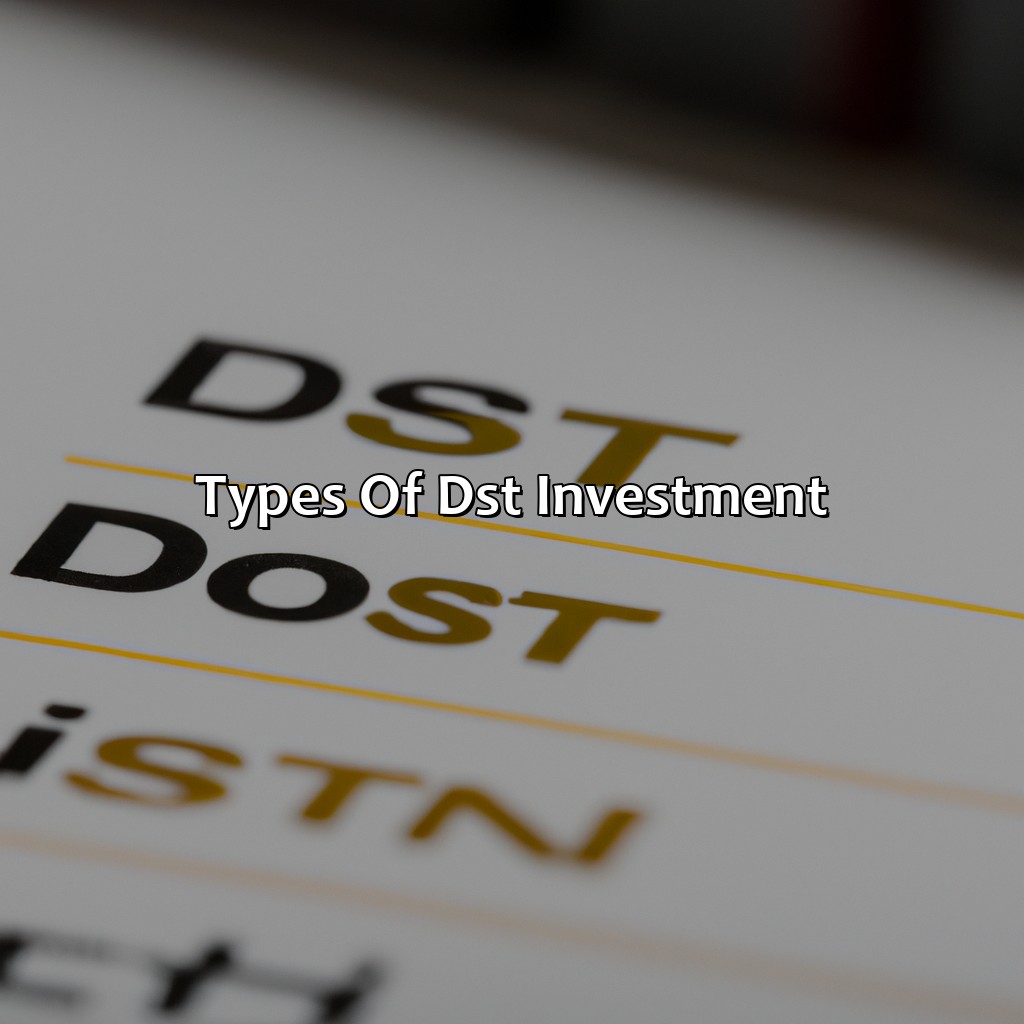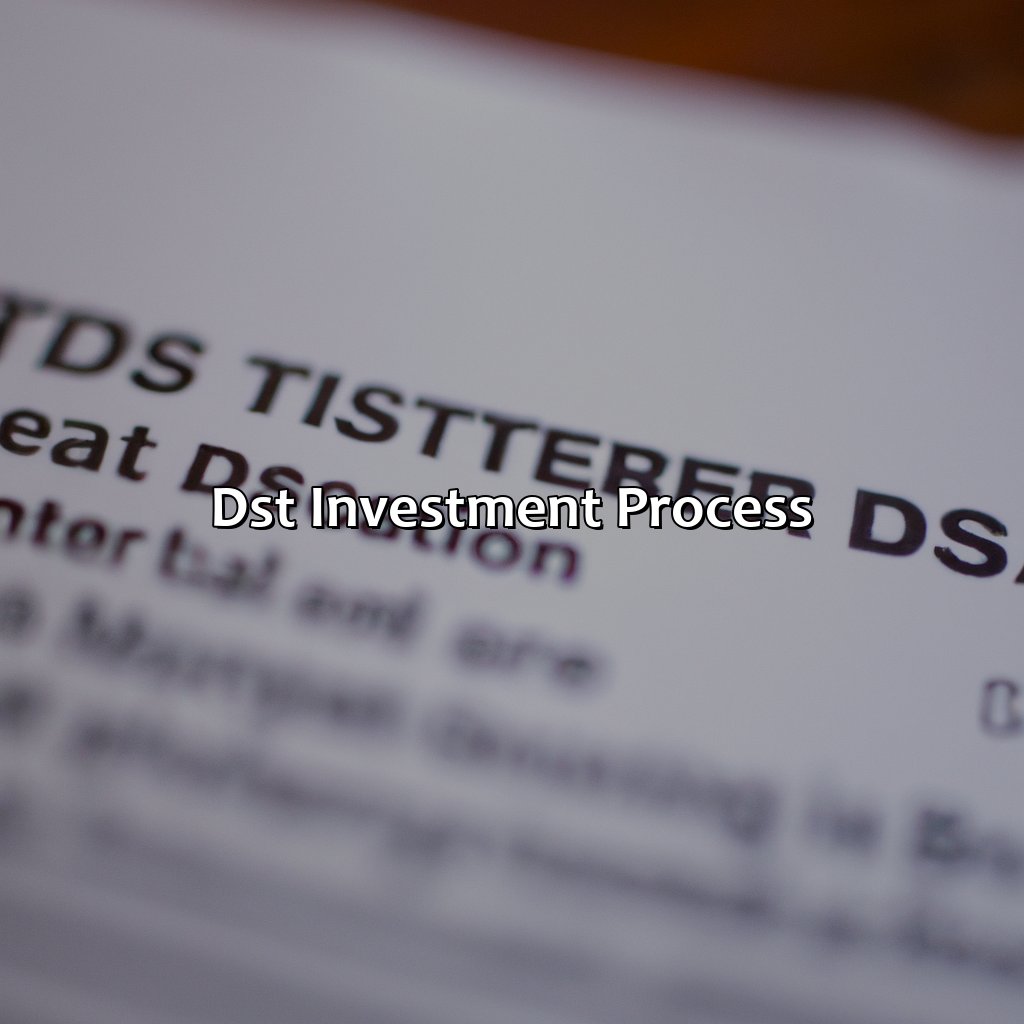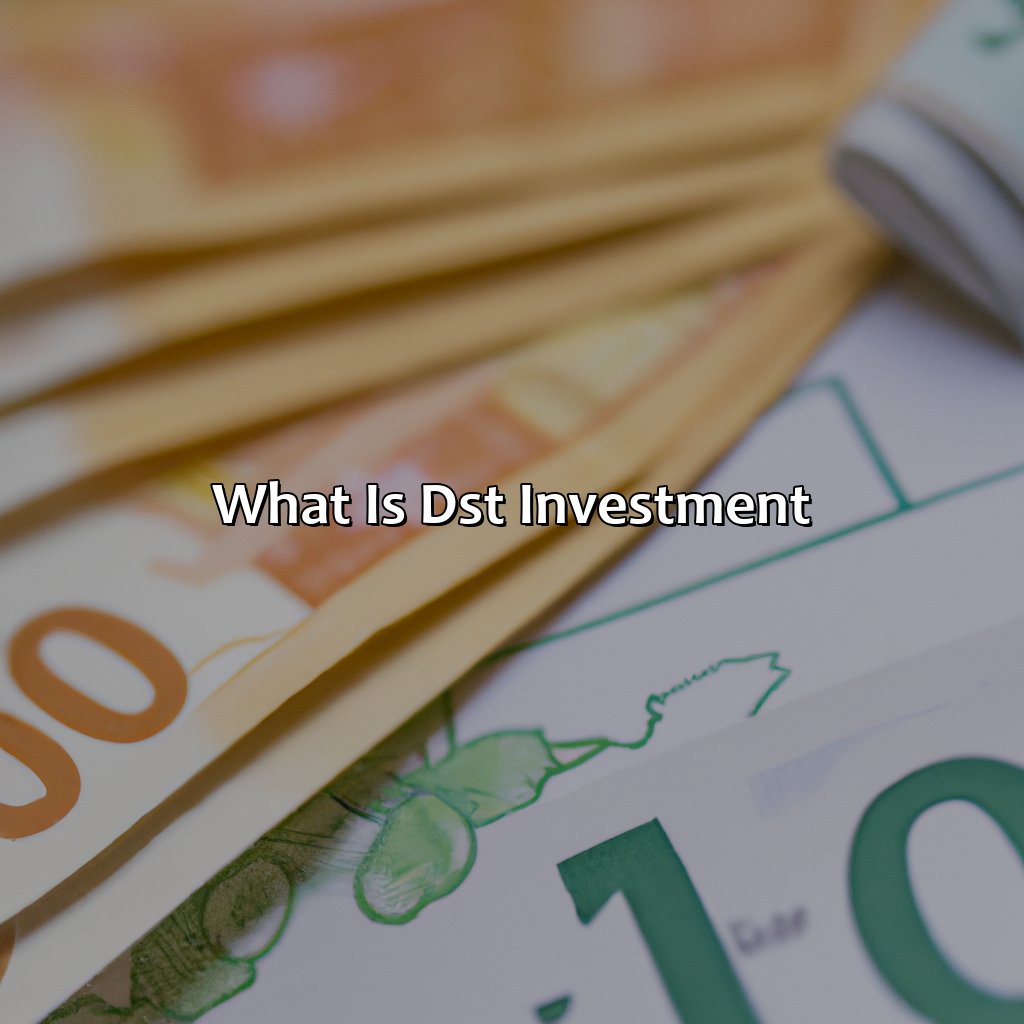What Is Dst Investment?
Key Takeaway:
- DST investment is a popular method of investing in real estate without the hassles of property management. DST investors own a fractional interest in the property and receive passive income and tax benefits without having to actively manage the property.
- Among the several advantages of DST investment, a few major ones include diversification of portfolio with fractional ownership, higher potential returns on investments, low initial investment cost, and tax benefits such as deferred capital gains tax.
- DST investment comes in different types such as 1031 Exchange, Fractional Ownership, and Tenancy in Common. Each type has its own unique advantages and disadvantages, and investors should evaluate their investment goals, risk tolerance, and cash flow requirements before investing in a DST.
Are you considering investing in DST but not sure what it is? DST investments are an increasingly popular option, with a unique set of benefits that can help you maximize your retirement savings. Read on to learn more about how DST investments work and how they could work for you.
Understanding DST Investment
To get the hang of DST investment, dive into its advantages and definition. This will help you see how it is different from other real estate investments. You’ll then get a better understanding of its purpose.

Image credits: retiregenz.com by David Woodhock
Definition of DST Investment
DST Investment is a real estate investment strategy in which individual investors pool resources to purchase interest or shares in properties. This enables investors to access larger and expensive commercial properties that would have been out of reach for individual investors. Through DST, the burden of property management and supervision is handed over to professional asset managers, thus freeing the investors from those tasks.
Typically, DST Investment works by acquiring interest in a large income-generating property such as an apartment complex, shopping mall, or office building. The property generates rental income and returns on investment are paid out to the investors. DST Investments qualify for 1031 exchange enabling investors who sell their investment property to defer tax liability by reinvesting the funds into one or more DSTs.
It’s worth noting that DST Investment is not suitable for everyone as it involves inherent risks associated with investing in real estate properties. Distributions may fluctuate and there is no guarantee of future returns, especially during economic downturns.
Interestingly, the concept of Delaware Statutory Trust (DST) originated from a ruling by Internal Revenue Service (IRS) which helped change how securitized 1031 exchanges operates between co-owners in tenants-in-common (TIC) structures. Today, DSTs serve as an alternative real estate investment platform that provides accredited investors access to larger and profitable commercial properties without having direct oversight or control over them.
Get ready to DSTroy your doubts about investing with these advantages of DST investment:
Advantages of DST Investment
DST Investment Benefits:
DST Investment unlocks numerous benefits for investors. These benefits encompass additional layers of security, tax exemptions, diversification of investment portfolios, and a shield against market volatility.
- Security: DSTs provide investors with added insurance to avoid potential losses and guarantee secure investments.
- Tax Exemptions: Investors may reduce their capital gains taxes by investing in DSTs and maintaining the eligibility of 1031 exchanges.
- Diversification: DST investments provide opportunities for investors to diversify their portfolios, increase flexibility by owning fractional shares, and benefit from multiple property ownership.
- Protection against Market Volatility: DSTs can protect investors’ investment returns and guard against uncertainty because they are immune to stock or bond market fluctuations.
In addition to these advantages, some unique aspects of DST Investment include elimination of associated property management duties and the ability to earn passive income.
Pro Tip: Consider consulting a reputable financial advisor before making any investment decision.
Get ready to choose your financial adventure with these types of DST investments – it’s like ‘Choose Your Own Adventure’ but with more money at stake.
Types of DST Investment
Investing in a DST? Check out the types available. Learn about DST 1031 Exchange, DST Fractional Ownership, and DST Tenancy in Common (TIC). They all have unique benefits and drawbacks. Consider them before investing!

Image credits: retiregenz.com by James Jones
DST 1031 Exchange
DST investment through a 1031 exchange allows investors to defer paying taxes on capital gains by exchanging their property for a share of a larger, diversified portfolio. This structure provides increased liquidity, reduced management responsibilities, and potentially higher returns. With DST 1031 Exchange, investors may also accommodate estate planning needs while enjoying passive income from long-term real estate investments.
Investing in DST 1031 Exchange offers the opportunity to access institutional-grade properties with a relatively low minimum investment amount. Investors can diversify their portfolio across multiple properties and markets, while benefiting from professional asset management and the advantages of passive ownership. The properties included in DSTs must meet strict criteria for financial stability and growth potential.
It’s important to note that investing in DST 1031 Exchange involves significant risks such as lack of control over individual assets and fluctuation in property values. However, an experienced sponsor can help mitigate these risks and provide thorough due diligence. According to Forbes, “The IRS has never successfully challenged [a] properly structured DST.”
In summary, DST 1031 Exchange is an investment structure that enables investors to defer taxes on capital gains by pooling funds with others into a diversified portfolio of institutional-grade properties with professional asset management. It is important for potential investors to consider the risks associated with this type of investment before proceeding.
Who needs a full piece of the pie when you can have a fractional slice? DST fractional ownership is like the Goldilocks of investments- not too big, not too small, but just right.
DST Fractional Ownership
Investing in fractional ownership of a DST gives you partial ownership of multiple commercial real estate properties. This form of investment allows for sharing risks and rewards with other investors.
The following table shows some examples of DST fractional Ownership properties:
| Property | Location | Asset Class | Ownership % |
|---|---|---|---|
| ABC Tower | New York | Office | 10% |
| XYZ Plaza | Los Angeles | Retail | 5% |
| DEF Complex | Chicago | Industrial | 15% |
DST fractional ownership provides access to quality assets and cash flow returns without requiring large capital investments. Each property has a unique business plan and projected returns, ensuring diversification across different markets and industries.
Investors with limited experience or time can benefit from the professional management services provided by DST sponsors. Careful consideration is required when selecting a sponsor who will oversee the daily operations, leasing agreements and financial reporting of the properties.
To maximize returns, it’s crucial to research the sponsor’s track record, asset selection process, and fees to ensure their strategy alignment with individual objectives. Also, regularly revisiting one’s portfolio is necessary to keep it up-to-date with new opportunities while maintaining an appropriate level of risk tolerance.
Investing in DST Tenancy in Common (TIC) is like having multiple roommates who are all responsible for paying the rent, except the rent is an investment and your roommates are accredited investors.
DST Tenancy in Common (TIC)
DST Investment in TIC allows multiple investors to co-own a property, enabling individual shares of revenue and expenses. This form of investment is suitable for those seeking diversity, long-term returns and tax-efficient benefits.
TIC has potential drawbacks including high fees, funding obligations and communication challenges due to the multiple ownerships.
Pro Tip: Consider the help of professional financial advisors while investing in DST Tenancy in Common.
From paperwork to profits, the DST investment process is like a rollercoaster ride – buckle up tight!
DST Investment Process
To become a DST Investment Pro, you must:
- Find the right investment
- Do your due diligence
- Invest in DSTs
Take the time to look into the market for suitable DST options. Do your research thoroughly and make wise investment decisions. Your hard work will pay off in the long run with DSTs!

Image credits: retiregenz.com by Adam Arnold
Finding the Right DST Investment
The Process of Selecting the Best DST Investment
When it comes to selecting a DST investment, understanding the investment process is crucial. First, identify your investment goals and risk tolerance levels. Then, conduct thorough research to evaluate different DST investments’ potential for profitable returns. Lastly, select a trustworthy and experienced sponsor with a track record of managing successful DST investments.
It is also essential to consider financial, tax, and legal implications when making your selection. Consult with professionals who can provide guidance on any financial or legal elements related to DST investments before committing.
Choosing the right DST investment requires careful consideration of multiple factors, from expected return rates to adequate risk analysis. Partnering with an experienced professional in the field can help navigate this complex and ever-changing landscape while staying within individual investment objectives and requirements.
To ensure success in your future investments, keep specific criteria in mind such as choosing sponsors with experience managing similar projects. Analysis of market trends can also play a vital role in decision-making throughout the process. Ultimately, thoughtful considerations taken at each step along the way will lead you closer to finding the best fit for your investing needs.
Doing due diligence is like kissing strangers at a party; you’re not quite sure who to trust, but you gotta do it to avoid the regret later.
Due Diligence
When evaluating a potential investment, our team utilizes a robust and meticulous investigation process called thorough examination. This method of assessing an investment opportunity encompasses researching financial statements, management capabilities, market trends and competition analyses to ensure the accuracy and viability of the deal. We exercise caution in this stage as it is imperative to make informed choices that align with our clients' goals.
Our due diligence procedure aims to identify all possible risks and opportunities linked with an investment. By investigating the company's operations, performance history and financial data, we provide a comprehensive report that aids in the decision-making process. During this review phase, we employ a range of strategies like interviews with stakeholders or industry experts, site visits, background checks for key management personnel among others.
By adhering to these rigorous procedures during due diligence investigations, we are confident of identifying both unforeseen risks and valuation opportunities that may arise from an investment. In implementing such measures, we ensure transparency and honesty in our process providing investors with complete confidence while making data-driven investment decisions.
Pro-tip: Due Diligence is crucial as it safeguards investors from unnecessary risk factors that may substantially affect their portfolio growth in the long term.
Time to DSTress and invest in DST, because when it comes to financial security, sunrise and sunset don't matter.
Investing in DST
It is advised to know the prospects and risks of the deal, have an exit strategy at hand, analyze the property valuation and its appreciation rate, monitor cashflow projections, and adhere to legal restrictions for effective results. Being aware of these aspects helps make informed decisions, reduces unforeseen risks, and provides optimizable returns on investments.
Furthermore, familiarize yourself with payment structures as different DST’s can have varying upfront costs or financing terms. Enlisting the service of a financial advisor specializing in this domain can help improve profitability while mitigating risks involved with this sort of investment.
Five Facts About DST Investment:
- ✅ DST Investment is a type of venture capital firm that invests in late-stage technology startups. (Source: TechCrunch)
- ✅ The firm was founded by Russian-born entrepreneur Yuri Milner in 2009. (Source: Crunchbase)
- ✅ DST Investment has made several high-profile investments in companies like Facebook, Twitter, and Airbnb. (Source: Forbes)
- ✅ The firm has offices in Moscow, London, and Menlo Park, California. (Source: DST Global)
- ✅ DST Investment has been involved in several large-scale investment deals, including a $1.5 billion investment in JD.com in 2014. (Source: Wall Street Journal)
FAQs about What Is Dst Investment?
What is DST Investment?
DST (Delaware Statutory Trust) is a legal entity used for asset ownership and investment purposes. It is commonly used in real estate investing as a way to pool funds for the acquisition of high-value properties.
What are the Benefits of DST Investment?
DST investment offers several advantages, including limited liability, tax benefits, lower minimum investment requirements, diversification of assets, and consistent cash flow.
Who is Eligible to Invest in DST?
Anyone can invest in DST, regardless of their income or net worth. However, certain investments may have minimum investment requirements.
How does DST Investment differ from traditional real estate investing?
DST investment differs from traditional real estate investing in that it allows investors to own fractional shares of institutional-grade properties, offering the potential for higher returns with lower risk.
What is the minimum investment required for DST?
The minimum investment required for DST investment varies depending on the investment opportunity. Generally, the minimum investment required is between $25,000 and $100,000.
How do I find DST investment opportunities?
There are several ways to find DST investment opportunities, including working with a financial advisor, searching online databases, and attending investment seminars. It’s important to do thorough research before investing in any opportunity.
